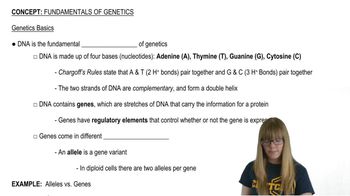Table of contents
- 1. Introduction to Genetics51m
- 2. Mendel's Laws of Inheritance3h 37m
- 3. Extensions to Mendelian Inheritance2h 41m
- 4. Genetic Mapping and Linkage2h 28m
- 5. Genetics of Bacteria and Viruses1h 21m
- 6. Chromosomal Variation1h 48m
- 7. DNA and Chromosome Structure56m
- 8. DNA Replication1h 10m
- 9. Mitosis and Meiosis1h 34m
- 10. Transcription1h 0m
- 11. Translation58m
- 12. Gene Regulation in Prokaryotes1h 19m
- 13. Gene Regulation in Eukaryotes44m
- 14. Genetic Control of Development44m
- 15. Genomes and Genomics1h 50m
- 16. Transposable Elements47m
- 17. Mutation, Repair, and Recombination1h 6m
- 18. Molecular Genetic Tools19m
- 19. Cancer Genetics29m
- 20. Quantitative Genetics1h 26m
- 21. Population Genetics50m
- 22. Evolutionary Genetics29m
7. DNA and Chromosome Structure
DNA Structure
Problem 16c
Textbook Question
Which of the following equations are true for the percentages of nucleotides in double-stranded DNA?
(A)/(T)=(G)/(C)
 Verified step by step guidance
Verified step by step guidance1
Understand the structure of double-stranded DNA: DNA is composed of four nucleotide bases - adenine (A), thymine (T), guanine (G), and cytosine (C). In double-stranded DNA, base pairing occurs such that A pairs with T and G pairs with C.
Recall Chargaff's rules: Chargaff's rules state that in double-stranded DNA, the amount of adenine (A) is equal to the amount of thymine (T), and the amount of guanine (G) is equal to the amount of cytosine (C). This can be expressed as A = T and G = C.
Analyze the given equation: The equation provided is (A)/(T) = (G)/(C). Using Chargaff's rules, substitute A = T and G = C into the equation. This simplifies the equation to 1 = 1, which is true.
Interpret the equation: The equation (A)/(T) = (G)/(C) essentially reflects the proportionality of nucleotide pairing in double-stranded DNA. Since A pairs with T and G pairs with C, the ratios of A to T and G to C are both equal to 1.
Conclude the validity of the equation: Based on Chargaff's rules and the structure of double-stranded DNA, the equation (A)/(T) = (G)/(C) is true for the percentages of nucleotides in double-stranded DNA.
 Verified video answer for a similar problem:
Verified video answer for a similar problem:This video solution was recommended by our tutors as helpful for the problem above
Video duration:
3mPlay a video:
Was this helpful?
Key Concepts
Here are the essential concepts you must grasp in order to answer the question correctly.
Chargaff's Rules
Chargaff's Rules state that in double-stranded DNA, the amount of adenine (A) is equal to thymine (T), and the amount of guanine (G) is equal to cytosine (C). This means that A pairs with T and G pairs with C, leading to the conclusion that the ratios of these nucleotides are consistent across different organisms.
Recommended video:
Guided course

Genetics Basics
Base Pairing
Base pairing refers to the specific hydrogen bonding between nucleotide bases in DNA. Adenine pairs with thymine through two hydrogen bonds, while guanine pairs with cytosine through three hydrogen bonds. This complementary pairing is crucial for the stability of the DNA double helix and ensures accurate DNA replication.
Recommended video:
Guided course

Base Distortions
Double-Stranded DNA Structure
Double-stranded DNA consists of two strands that run in opposite directions, forming a double helix. Each strand is composed of a sugar-phosphate backbone and nitrogenous bases. The antiparallel nature of the strands and the specific base pairing are essential for the integrity and function of genetic material, influencing processes like transcription and replication.
Recommended video:
Guided course

DNA Structure
Related Videos
Related Practice
Textbook Question
Adenine may also be named 6-amino purine. How would you name the other four nitrogenous bases, using this alternative system? (O is indicated by 'oxy-,' and CH₃ by 'methyl.')
824
views


